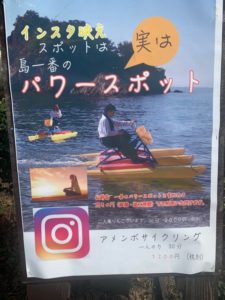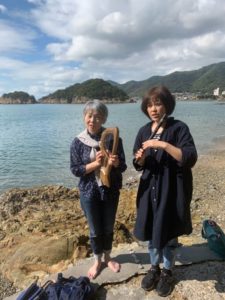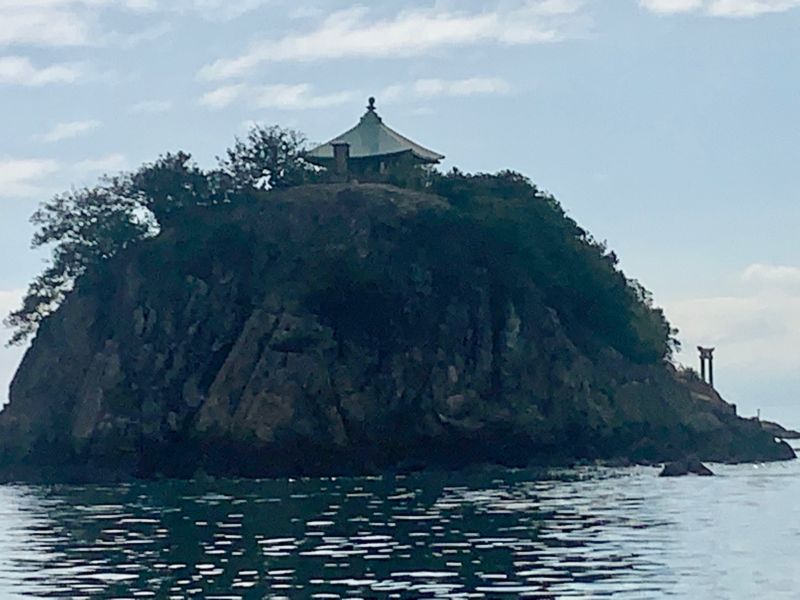
On a recent visit to the charming town of Tomonoura I was delighted to come across an alternative to mainstream Shinto in the form of the two ladies pictured above. It happened at a so-called ‘power spot’ on the island of Sensuijima, a ten-minute ferry ride from the Tomonoura port.
Because of the power spot boom in recent years, it is not uncommon these days to come across places advertising themselves as power spots, as in the poster below. Though it proudly proclaims Sensui Island to be a ‘powerspot’, the main image is of leisure activities. It shows how the spiritual frisson of ‘a powerspot’ gives an extra dimension to sightseeing attractions.

While walking around the attractive coastline of the island, I came across two females playing music on a sandy beach. They were facing out to sea and I recognised from the sound of the flute that they were playing music for the kami. What I didn’t recognise was one of the instruments – a handmade kinderharp, so I took the opportunity to ask about it (see top picture).
It turned out that one of the women was from Nara and the other from Izumo, and that they shared an interest in spiritual matters. This was of their own devising, based on intuitive response to place and person.
On this occasion the two women had come to Sensui Island because the island had the same kind of rock as Nushima, the small island off Awajijima where the primal pair of Izanagi and Izanami are said to have descended in the origin myth of Japan. (See here for details.)
Having sensed a spiritual power on Nushima, the women had learnt that Sensui Island had the same kind of rock formation and were exploring whether there was a similar energy. And to aid them in their endeavour, they were beseeching the kami of place to favour their cause by offering music on flute and harp.

When talk turned to the transmission of energy, one of the women claimed to have special ‘hand power’. She performed a brief healing ceremony by holding her hand over my heart while her friend played a musical accompaniment. It had a calming effect, and I felt a strange kind of internal warmth.
Being socially conservative, Japan is often thirty or more years behind the West in emerging fashions (smoking, gay rights and vegetarianism provide examples). The activities of the two women not only spoke to a New Age influence, but recalled the search for authenticity by the hippies of the 1960s who turned to standing stones and ancient sites – ‘power spots’.

But quite apart from the Western borrowings, I couldn’t help feeling that there was here too a throwback to the ancient Japanese tradition of direct communication with the kami by ‘miko’ shamans. As in the past, the women represent an unconventional and unregulated form of spiritual practice that is threatening to the male guardians of authority. It helps explain why the Association of Shrines is wary of endorsing the phenomenon of power spots. Clearly it is out of step with the ‘invented tradition’ of post-Meiji Shrine Shinto, with its emperor-centred policies and nationalistic leanings.
For those of us in search of communion with nature through heightened consciousness, the women offer a living alternative to the fossilised rituals of orthodoxy. They embody indeed an inspiring example of an independent search for truth conducted outside the narrow perimeters of religious dogma and prescription.
Here were free spirits on a power spot pilgrimage. It was a most liberating encounter.


Thank you for sharing, lovely ladies.
Inspiring! Thank you, John. Blessed Be kami and free-spirited ladies.
With all due respect, I must disagree on many points.
New Age and all the similar modern western mysticism is fundamentally a product of white culture that cleared itself from any religious authenticity and diversity via christianization, only to patch its hunger for non-abrahamic spirituality by thoughtless cultural appropriation.
Is it therefore weird to place western world above Japan, where animism and shamanism remain a (barely) living tradition.
In the country where I live, pre-christian spirituality is stone-cold dead, with no movement to revive it ever. Yet New Age, or similar practices, are living and well. Psychics, healers, geopathogenous zones, energy balancing are everywhere, usually using pre-processed and marketed “religious” traditions; yet our country remains reactionary, homophobic, racist and anti-ecologic as ever.
Speaking more concretelly, shamanism and animism, Shinto, must recognize agency of spirits (kami); belief in power spots on the contrary states that anybody can aproach this place and syphon its energy as a charge from capacitor, without any knowledge of local kami. That’s deeply degrading in my opinion.
Thank you for the comment, and you’re of course entitled to your opinion. We live in a postmodern age, and spiritual development is inevitably going to cross borders. Nothing you or I can do to stop it, unless of course you want to be seen as another King Canute…